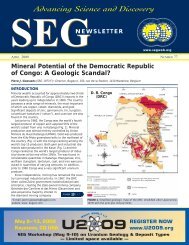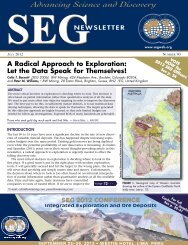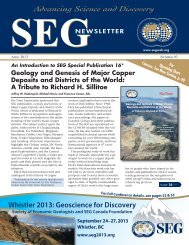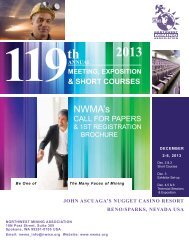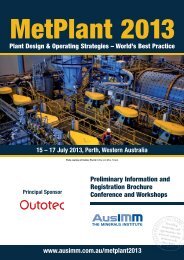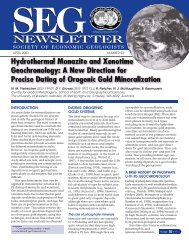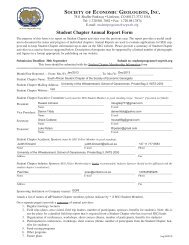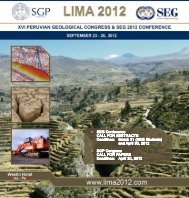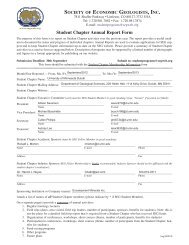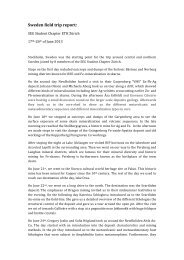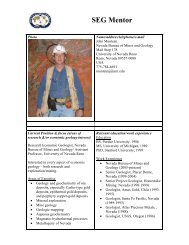Crucial Challenges to Discovery and Mining: Tomorrow's Deeper Ore
Crucial Challenges to Discovery and Mining: Tomorrow's Deeper Ore
Crucial Challenges to Discovery and Mining: Tomorrow's Deeper Ore
You also want an ePaper? Increase the reach of your titles
YUMPU automatically turns print PDFs into web optimized ePapers that Google loves.
2012 SEG<br />
Distinguished<br />
Lecture
Society of Economic Geologists (SEG)<br />
Established in 1920, the SEG is committed <strong>to</strong><br />
“Advancing Science <strong>and</strong> <strong>Discovery</strong>.”<br />
Goals:<br />
~ Sponsor Scientific Investigations<br />
~ Disseminate Results<br />
~ Support the Profession Globally
Society of Economic Geologists (SEG)<br />
International Society<br />
~ Members in 100 Countries<br />
~ 71% of Members are from outside the USA<br />
Member Affiliation:<br />
~ 60% Industry (50/50 Corporate/Self-Employed)<br />
~ 20% Academia & Government<br />
~ 20% Students
Society of Economic Geologists (SEG)<br />
Peer Networking<br />
~ 6,500 Members – online direc<strong>to</strong>ry<br />
SEG Publications<br />
~ Economic Geology<br />
~ SEG Newsletter<br />
~ Special Publications & Reviews<br />
Foundation Student Programs<br />
~ Research Grants, Fellowships, Field Trips<br />
~ Student Men<strong>to</strong>ring Program<br />
~ Student Chapter Program<br />
(60 active student chapters in 22 countries)
Society of Economic Geologists (SEG)<br />
Professional Development<br />
~ Conferences, Short Courses, <strong>and</strong> Field Trips<br />
~ SEG Traveling Lecturers<br />
~ Distinguished Lecturer<br />
~ International Exchange Lecturer<br />
~ Thayer Lindsley Lecturer<br />
~ Regional VP Lecturer<br />
~ Honorary Lecturers
<strong>Crucial</strong> <strong>Challenges</strong> <strong>to</strong><br />
<strong>Discovery</strong> <strong>and</strong> <strong>Mining</strong><br />
Tomorrow’s <strong>Deeper</strong> <strong>Ore</strong> Bodies
Lecture Objectives<br />
• Focus on mass mining<br />
• Identify some challenges<br />
• Link discovery & mining<br />
• Show “deep’’ is difficult/ but possible
Content<br />
• ‘Deep Earth’ <strong>and</strong> mass mining<br />
• <strong>Discovery</strong> & mining – challenges<br />
• Some Cadia discovery examples<br />
• Posit some reflections
Cadia Discoveries*<br />
*porphyry Au/Cu mineralisation<br />
• Cadia Hill – cropped out – open pit<br />
• Cadia Quarry – cropped out<br />
• Ridgeway – 500 m deep – sublevel cave<br />
• Cadia East – >200 m deep<br />
• Cadia Far East – 800 m deep – Super-cave<br />
• Total mineral resource of > 44 M oz Au &<br />
7.5 M t Cu
‘Deep Earth’ for mass mining<br />
• <strong>Crucial</strong> <strong>to</strong> future mining/discovery<br />
• Constrained economically<br />
• Present u/g range: 300 – 2,000 m?<br />
• Future u/g depth limit – 3,000 m?<br />
• Present o/p range: 0 – 1500m?
<strong>Discovery</strong> Implications<br />
• Deposit geometry/area crucial<br />
• Surface-area will influence:<br />
• Very deep open pits (Ultra-deep)<br />
• Very large cave mines (Super-caves)
Surface Area Effects<br />
• Surface area affects the waste <strong>to</strong> ore<br />
(W:O) ratio in an open pit – Ultradeep<br />
pits require a large surface area<br />
• Block cave mines generally have<br />
smaller surface dimension – Supercaves<br />
require a large surface area <strong>to</strong><br />
maximise panel caving
<strong>Discovery</strong> <strong>Challenges</strong><br />
• Geology-related<br />
• <strong>Mining</strong>-related<br />
• Corporate – self-inflicted
Geology-related<br />
• Subtle/zero near-surface evidence<br />
• Obscuring & poor 4D geology<br />
• <strong>Ore</strong> deposit ‘models’<br />
• Rock temperatures
<strong>Mining</strong>-related<br />
• Mass mining trend<br />
• ‘Deep Earth’ depth constraints<br />
• Ultra-deep open pits & Super-caves<br />
• Future ore grade – in 10 or 20 years
Some <strong>Mining</strong> Effects<br />
• Capital Intensity<br />
• Political Risk – adds <strong>to</strong> cost<br />
• <strong>Ore</strong> Grade & Operating Cost<br />
• Increasing need for by-product credit<br />
• Use of NPV <strong>to</strong> determine mine size
Possible ‘Wild Card’<br />
• ‘State Capitalism’<br />
• Increasing world influence<br />
• “The world’s ten biggest oil-<strong>and</strong>-gas<br />
firms, measured by reserves, are all<br />
state-owned” – The Economist, January 2012
Capital Intensity vs Cu Price for<br />
New Cu Mines, 2001 - 2010<br />
10000<br />
8000<br />
9000<br />
7000<br />
8000<br />
6000<br />
7000<br />
Capital<br />
Intensity<br />
US$/t<br />
6000<br />
5000<br />
4000<br />
3000<br />
2000<br />
Cu Price (av.)<br />
US$/t<br />
Capital Intensity<br />
US$/t of copper production/yr<br />
(3 year rolling av.)<br />
5000<br />
4000<br />
3000<br />
2000<br />
Cu<br />
Price<br />
US$/t<br />
1000<br />
1000<br />
0<br />
2001 2002 2003 2004 2005 2006 2007 2008 2009 2010<br />
0<br />
(Source: Metals Economics Group’s Cu Reserves Replacement Strategies, June 2011)<br />
NOTE: by-product credit not included in capital intensity calculation
Capital Intensity vs Cu Mine Head Grade,<br />
2001 - 2010<br />
10000<br />
1.2<br />
9000<br />
8000<br />
1<br />
7000<br />
0.8<br />
6000<br />
5000<br />
Weighted Average<br />
Head Grade<br />
% Cu<br />
0.6<br />
US$/t<br />
4000<br />
3000<br />
0.4<br />
%Cu<br />
2000<br />
1000<br />
Capital Intensity<br />
US$/t of copper production/yr<br />
(3 year rolling av.)<br />
0.2<br />
0<br />
2001 2002 2003 2004 2005 2006 2007 2008 2009 2010<br />
0<br />
(Source: Metals Economics Group’s Cu Reserves Replacement Strategies, June 2011)<br />
NOTE: by-product credit not included in capital intensity calculation
t/yr<br />
Capital Intensity vs Production Capacity<br />
for New Cu Mines, 2001 - 2010<br />
450000<br />
10000<br />
400000<br />
9000<br />
350000<br />
8000<br />
300000<br />
250000<br />
200000<br />
Production Capacity<br />
t/yr of copper<br />
(3 year av.)<br />
7000<br />
6000<br />
5000<br />
4000<br />
US$/t<br />
150000<br />
100000<br />
50000<br />
Capital Intensity<br />
US$/t of copper production/yr<br />
(3 year rolling av.)<br />
3000<br />
2000<br />
1000<br />
0<br />
2001 2002 2003 2004 2005 2006 2007 2008 2009 2010<br />
0<br />
(Source: Metals Economics Group’s Cu Reserves Replacement Strategies, June 2011)<br />
NOTE: by-product credit not included in capital intensity calculation
Production <strong>Challenges</strong><br />
• Top ten Cu mines in 2010 produced:<br />
• Open pit: 245 – 1,000 kt Cu/yr<br />
• Underground: 80 – 425 kt Cu/yr<br />
• Set against increasing Cu dem<strong>and</strong>
Copper Dem<strong>and</strong><br />
• 1900 – 0.5 M t<br />
• 1930 – 1.9 M t<br />
• 1960 – 3.2 M t<br />
• 1990 – 8.1 M t<br />
• 2009 – 16.0 M t<br />
• 2030 – ?30 M t or ><br />
• 4 % growth/year
2010 Top Ten Cu Mines<br />
• Open pit <strong>to</strong>tal – 4.5 M t Cu<br />
• Underground <strong>to</strong>tal – 2.2 M t Cu<br />
• Combined <strong>to</strong>tal – 6.7 M t Cu<br />
• 2009 dem<strong>and</strong> – 16.0 M t Cu
Equipment Size – an Issue<br />
• Only incremental increases<br />
• 300 t trucks, after 30 – 40 years<br />
• 55 cu m Shovels<br />
• SAG Mills 40 – 42 ft/float cells?
<strong>Discovery</strong> <strong>to</strong> Production<br />
• Lengthening time<br />
• Impacts future target grade<br />
• > 5 M oz Gold deposit now > 10 years<br />
• > 5 Mt Copper deposit is > 20 years
Some Copper Examples<br />
• All still in feasibility study stage<br />
• El Pachon, Argentina – >48 years<br />
• Frieda River, PNG – >42 years<br />
• Galeno, Peru – >20 years<br />
• Tampakan, Philippines – >19 years<br />
• Resolution, USA – >16 years
Corporate Challenge<br />
• Growth – discovery vs M & A<br />
• Leadership vs management<br />
• Growth = management = bureaucracy<br />
• <strong>Discovery</strong> has <strong>to</strong> be led
Typical Corporate Trend<br />
Strong<br />
leadership,<br />
entrepreneurial<br />
Weak<br />
leadership,<br />
entrepreneurial<br />
Weak<br />
management/<br />
bureaucracy<br />
Strong<br />
management/<br />
bureaucracy<br />
Growth: Junior<br />
Major miner
Corporate Challenge Cont.<br />
• Bewilderment with discovery process<br />
• <strong>Discovery</strong> risk – not unders<strong>to</strong>od<br />
• Desire <strong>to</strong> ‘manage’ discovery<br />
• Need for discovery ‘business model’
<strong>Discovery</strong> ‘Business Model’<br />
• Not running a fac<strong>to</strong>ry<br />
• Forget conventional theory<br />
• Antithesis of the ‘need <strong>to</strong> measure’<br />
• Encourage creativity – no rules
Past Discoveries<br />
• ‘Easy’ <strong>to</strong> make ?<br />
• Surface/near-surface – prospecting<br />
• ‘Good’ geology often important<br />
• Some were ‘Deep Earth’
A Prior <strong>Discovery</strong> Model<br />
• “Where best <strong>to</strong> look – shadow of the<br />
headframe” – Sig. Muessig, Getty<br />
• Why – “the closer <strong>to</strong> ore, the lower<br />
the risk” – Sig. Muessig, Getty
An Example: Cadia Hill<br />
• ‘Old-fashioned’ & ‘easy’?<br />
• Surface prospecting<br />
• Influenced by people, time, gold<br />
price <strong>and</strong> geological thinking
“Lateral” Comparison<br />
• Ok Tedi porphyry Au/Cu deposit<br />
• Skarn & Ok Tedi porphyry – yes<br />
• Skarn & Cadia porphyry – why not?<br />
• Supporting evidence – where?
“Lateral” Thought<br />
Mineralised<br />
Waste<br />
Altered<br />
waste &<br />
skarn<br />
<strong>Ore</strong> &<br />
Ok Tedi<br />
3D dartboard
Western Cadia Hill – prior <strong>to</strong> discovery
Cadia Hill: Pre-Newcrest Exploration<br />
Results
Cadia Hill: Soil Geochemistry
Cadia Hill: Explora<strong>to</strong>ry Drilling Concept<br />
Conceptual Pits
<strong>Discovery</strong> hole<br />
Cadia Hill: <strong>Discovery</strong> Drilling
Cadia Hill: Section 14,020E
Cadia Hill Core - hole NC38
Cadia Hill: Section 14,020E – Gold Intersections
Ridgeway<br />
subsidence zone<br />
Ridgeway<br />
decline portal<br />
Cadia Hill<br />
open cut
‘Deep Earth’ Discoveries<br />
• More difficult & less ‘obvious’<br />
• Much greater depth<br />
• Possibly lower grade<br />
• Need <strong>to</strong> be much larger
Transitional ‘Deep Earth’<br />
• 200 – 500 m <strong>to</strong> <strong>to</strong>p of ore<br />
• Not presently open pit?<br />
• Geometry/grade determine mining<br />
• Mass underground mining is likely
Ridgeway Deposit<br />
• Completely blind<br />
• 500 m deep<br />
• 20-80 m post-mineral cover<br />
• Weak mineralisation halo
Cadia East<br />
Longsection 21,750mN<br />
Geology<br />
Pre-<strong>Discovery</strong> of Cadia Far<br />
East
IP Traversing<br />
• Trialled over Cadia Hill/East<br />
• 200 m dipole-dipole array<br />
• Deep low-order chargeability responses<br />
• Possibly good for 200 m cover
Ridgeway
Fault
Early Subsidence
Mass <strong>Mining</strong> Trend<br />
• Much larger scale & depth<br />
• Ultra-deep pits – 1500 m deep<br />
• Super-caves – 2000 m deep<br />
• Increasing au<strong>to</strong>mation
A Current Large Open Pit<br />
• Two pits – sulfide & leach Cu ores<br />
• 250 k tpd sulfide & 200 k tpd leach<br />
• 750 k tpd waste;
Hypothetical<br />
Ultra-deep<br />
Pit<br />
• Pit:<br />
11 km x 5.5 km.<br />
• Depth:<br />
1500 m<br />
• <strong>Ore</strong> milled:<br />
0.8 – 1.5 M tpd.<br />
• Waste removed:<br />
> 3.0 M tpd.
Potential Size Increase<br />
• <strong>Ore</strong> treated: by up <strong>to</strong> x3<br />
• Waste removed: more than x4<br />
• Total moved: 1.8 billion <strong>to</strong>nnes per<br />
year
Evolution of Cave mining<br />
(Courtesy of Chi<strong>to</strong>mbo, 2011)<br />
1970s &1980s<br />
1980s <strong>to</strong> 2010 2010 -2020<br />
Emergence of<br />
Beyond Supercaves<br />
Super-caves<br />
1898<br />
First Block Cave<br />
Pewabic Mine (Iron <strong>Ore</strong>)<br />
Contemporary<br />
caves<br />
Strong rocks at<br />
moderate depths<br />
Massive footprints<br />
Lower grades<br />
Deep deposits<br />
In-situ metal<br />
recovery ??<br />
Grizzly <strong>and</strong> slusher systems<br />
Panel caving<br />
Weak rocks <strong>and</strong> shallow depths
Cost Comparison<br />
Sublevel S<strong>to</strong>ping (SLS)<br />
Sublevel Caving (SLC)<br />
<strong>Mining</strong> cost<br />
reduction<br />
~50%<br />
Block Caving (BC)<br />
Panel Caving (PC)<br />
AIRGAP<br />
CAVE BACK<br />
CAVE ORE<br />
Lower<br />
Capital<br />
Costs<br />
OREBODY<br />
DRAWPOINTS<br />
NEXT PANEL<br />
UNDERCUT ADVANCE<br />
After Flores 2011
E26 Op encu t Min e<br />
Some Current Caving Styles<br />
N<br />
E<br />
Ven tilation Sh aft<br />
Porta l<br />
Cave as at<br />
7 Dec 1999<br />
Hoisting<br />
Shaft<br />
One Leve l<br />
Cave back as<br />
at 22 Oct 1999<br />
Ret urn Airwa y<br />
Sha ft Ac cess Decline<br />
Loa ding<br />
Station<br />
Contro l Room<br />
& Wor kshop<br />
Conveyor Incline<br />
NIVEL TRANSPORTE TTE.8<br />
LEVEL TENIENTE 8<br />
Crushe r No. 1<br />
Su blevel Ac cess<br />
De cline<br />
Northparkes Australia<br />
N<br />
E<br />
BRECHAS<br />
T4 SUR<br />
SUB 6<br />
PILAR<br />
2120<br />
ESMERALDA<br />
DIAMANTE SUR<br />
El Teniente Chile (courtesy Chi<strong>to</strong>mbo, 2011) Grasberg Indonesia
Possible Super-caves<br />
(Courtesy Chi<strong>to</strong>mbo, 2011)<br />
Grasberg<br />
N<br />
Grasberg<br />
open pit<br />
Kucing Liar<br />
Portals<br />
Big Gossan<br />
Mill<br />
DMLZ<br />
DOZ<br />
N<br />
Plan View<br />
Kucing Liar Spur<br />
Kucing<br />
Liar<br />
Big Gossan Spur<br />
Big<br />
Gossan<br />
Grasberg<br />
Block Cave<br />
Amole<br />
2,900 m elev<br />
Grasberg<br />
MLA<br />
BC Spur<br />
DMLZ Spur<br />
DOZ<br />
DMLZ<br />
Portals<br />
(at Ridge Camp)<br />
Common Infrastructure<br />
2,500 m elev<br />
Australia<br />
Indonesia<br />
Chile<br />
Mongolia
Likely Scale Comparison<br />
(Courtesy Chi<strong>to</strong>mbo, 2011)<br />
• Contemporary cave<br />
– Footprint= 200 m X 200 m<br />
– Block height < 500 m<br />
– Tonnage: 10,000 – 40,000 tpd<br />
– Undercut level = < 1000 m deep<br />
• Super-cave<br />
2000 m x 2000 m<br />
>500 – 800 m<br />
70,000 – 100,000 tpd (single panel)<br />
>1500 – 2000 m deep<br />
1500m<br />
77
‘Deep Earth’ Environment<br />
• >500 m – >1000 m <strong>to</strong> <strong>to</strong>p of ore<br />
• Obscuring post-mineral rocks<br />
• Science-based risk-taking essential<br />
• Robust deposit-halo models needed<br />
• Geophysics for ‘sulfur’ anomaly
Cadia Far East Deposit<br />
• 800 m <strong>to</strong> ore body <strong>to</strong>p<br />
• 100 – 200 m of post-mineral rock<br />
• ‘asking good questions’ <strong>and</strong> ‘testing<br />
these’ - Tedder, 2001<br />
• Technical key was Au:Cu vec<strong>to</strong>r
Cadia East<br />
Longsection 21,750mN<br />
Geology<br />
Pre-<strong>Discovery</strong> of Cadia Far<br />
East
Cadia East<br />
Longsection 21,750mN<br />
Alteration Zones<br />
Pre-<strong>Discovery</strong> of Cadia Far<br />
East
Cadia East<br />
Longsection 21,750mN<br />
Mineralisation Zones<br />
Pre-<strong>Discovery</strong> of Cadia Far<br />
East
Cadia Far East Beckons<br />
• > 1000 m Au/Cu mineralisation <strong>to</strong> SE<br />
• August 1996, hole NC494 from 1164 m<br />
• 112 m @ 2.1 g/t Au & 0.56 % Cu<br />
• within 229 m @ 1.3 g/t Au & 0.49 % Cu
Cadia East & Cadia Far East<br />
Longsection 21,750mN<br />
Mineralisation Zones
Cadia East & Cadia Far<br />
East<br />
Longsection 21,750mN<br />
Alteration Zones
Cadia East<br />
Longsection 21,750mN<br />
Geology
Increasing %Cu/Au:Cu<br />
? Increasing Au
Cadia East Mine Configuration<br />
(courtesy Newcrest <strong>Mining</strong> Limited)<br />
Cadia Hill Open<br />
Pit<br />
Vent<br />
Raises<br />
Vent<br />
Raises<br />
PC1-S2<br />
1,225m<br />
PC1-S1<br />
PC2-S1<br />
PC2-S2<br />
1,475m
Ridgeway<br />
subsidence zone<br />
Ridgeway<br />
decline portal<br />
Cadia Hill<br />
open cut<br />
Cadia East<br />
decline portal<br />
1,000 m
Thermal gradient<br />
• Rarely considered<br />
• Potentially significant issue<br />
• Resolution <strong>and</strong> Far Southeast<br />
• Engineering solutions/research<br />
required
<strong>Crucial</strong> <strong>Challenges</strong><br />
• 4D geology/better ore body models<br />
• Geometry/size/grade of target<br />
• Mine capital intensity & grade<br />
• Corporate diversions – culture effect
Some Reflections 1<br />
• <strong>Discovery</strong> is a business<br />
• Science-based risk-taking is essential<br />
• Risk needs <strong>to</strong> be reduced quickly<br />
• Success is more likely if low-risk
Some Reflections 2<br />
• Emulate past successes – lessons<br />
• New ore body models required<br />
• ‘Deep Earth’ isn’t scary<br />
• Just harder
Finally<br />
• Large deposits are easier <strong>to</strong> find<br />
• <strong>Discovery</strong> is r<strong>and</strong>om/unscripted<br />
• Correct exploration decisions are<br />
not always MBA material
Final Finally<br />
• Forget conventional wisdom<br />
• Think then act<br />
• “IQ gets you there ...<br />
• ...but NQ finds it” – Muessig, Getty
My Thanks To<br />
• Society of Economic Geologists<br />
• Newcrest <strong>Mining</strong> Limited<br />
• W H Bryan <strong>Mining</strong> <strong>and</strong> Geology<br />
Research Centre, University of Qld<br />
• Metals Economics Group of Canada<br />
• BHP Billi<strong>to</strong>n
Thank You
Top-ten Open Pit Cu Mines, 2010<br />
• Escondida, Chile – 1,011,00 t Cu<br />
• Grasberg, Indonesia – 603,284 t Cu<br />
• Chuquicamata, Chile – 528,377 t Cu<br />
• Collahuasi, Chile – 504,043 t Cu<br />
• Los Pelambres, Chile – 384,600 t Cu<br />
• Radomiro Tomic, Chile – 375,344 t Cu<br />
• Cerro Verde, Peru – 303,455 t Cu<br />
• Antamina, Peru – 301,455 t Cu<br />
• Bingham Canyon, USA – 249,800 t Cu<br />
• Batu Hijau, Indonesia – 245,850 (Source: MEG 2011)



